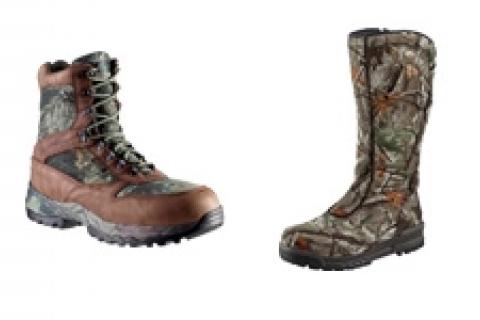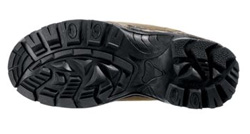
Stepping out has taken on a new meaning for women who enjoy the outdoors. We're breaking new ground and in ever increasing numbers, enjoying what many women in the past didn't consider pursuing: a passion for the hunt.
 |
| You can never go wrong with waterproof boots. |
For many, we're not just simply heading into the woods, we're venturing into new territory altogether when we embark on a hunting trip.A critical component of any successful hunting adventure is choosing the right gear.While many of us have a closet full of shoes, we still aren't sure what features to look for in a hunting boot. Make no mistake here — nothing can end a hunt quicker than sore, cold, wet feet.To make sure your first step is in the right direction, here are some tips on selecting the correct boot for your hunt.
Hunting Boot Selection for Terrain & Climate
Boot selection should focus on two key considerations of your hunt: terrain and climate. Both of these factors will dictate the type of boot you'll need. Many boots sold are available in non-insulated or insulated styles, and often in waterproof styles also. Changing weather is common during hunting seasons, and you can't go wrong in guaranteeing dry feet by ordering a pair of waterproof boots!
Study the weather of your intended hunting grounds, researching the temperatures and weather you'll likely encounter while hunting there. Know what type of land and land features you'll be setting your feet on. Use these criteria when searching for the right boot:
Mountainous, rocky or uneven terrain: This type of terrain requires boots with good, stiff ankle support, stiffer soles for stability, good lacing system for support, padded collar and tongue for comfort, waterproof protection for changing conditions, and good moisture-wicking properties to accommodate a lot of hiking and stalking. Common materials for "high-country" boots are leather or oiled leather uppers with rubber "bands" or toe guards for abrasion resistance and protection from rocks.
Upland hunting/open fields: Flatter terrain means you can use a softer, lighter weight boot, especially appreciated for the miles of walking you may do, and softer soles with less tread or traction are required. Lightweight leather or Cordura Nylon uppers are common, with waterproof and breathable linings a necessity. Also look for extra padding on the collar and tongue for all-day comfort.
Lowlands/marshes or swamps: Wet, sloppy ground calls for rubber boots or snake boots (if you hunt in the south).These boots are the tallest you'll find, with women's boots reaching 15-inch tops.Be sure to look for a snug ankle fit so they won't pull off in the mud, and side cinches or buckles at the top to eliminate a noisy, sloppy fit when you walk, and to help seal out moisture.
A removable foot bed is a definite plus, as rubber boots will become damp and won't dry out easily overnight unless you use boot dryers. Be certain to check the outer sole for cleats or lugs; a necessity for good traction in the mud.Although a great all around choice for water protection and varied terrain, rubber boots are not a comfortable boot to do extensive walking on uneven ground — they lack adequate support and cushioning needed for longer treks.
 |
| Snake boots that go high on the calf are important to have in snake country. |
Varied terrain: dense woods, ridges, meadows:Varied land features call for a boot with varied features — leather or nylon uppers (or a combination of the two) with a more flexible sole, breathable, waterproof linings, stable ankle support without being too stiff, and a medium weight and height.This will be a good all-around boot you'll reach for often and wear for many years if you make a smart purchase and a wise investment now.
Selecting Weight & Gram of the Boot
The weight of the boot you're selecting should be of concern, especially if you'll be doing a lot of walking. The fabric you choose, type of sole, and height and insulation will all contribute to the overall weight of your boot. The majority of boots will weigh anywhere from 3 to 4 pounds, with leather or heavily insulated pac boots hitting the scales in the 5-pound range.
Generally; choosing a lighter boot that's non-insulated or one with just 200-gram insulation will suffice for more active hunts, hunts in early season, or in milder weather.
For mid-season, cooler weather or less active hunts, it's imperative to purchase a quality-insulated boot with 400 to 800 grams of insulation. Thinsulate offers excellent insulation without adding bulk and weight — a great choice for hunts where you may do a combination of walking and standing. Changing mid-season conditions mean unpredictable weather, so be sure to purchase a pair of boots that are waterproof and breathable.
For late-season frigid weather and stand hunting, heavily-insulated, waterproof boots are a must. Heavy? Yes. The heaviest you'll find on the market, usually topping 5 pounds, but they're warm, and warm is what you'll need. Pac boots will often have removable liners with a cuff to seal out the cold air and snow, and cleated soles for good traction in snow and ice. Look for boots with insulation of 1,000 to 1,200 grams for the coldest, wintry conditions.
Key to Buying Women's Footwear
The key to buying women's footwear is in the width of the footwear. Women's sizes are designed to fit the narrower width of a women's foot. In addition, women's shoes and boots are cut to accommodate our narrower heel cup, meaning the heel will be trimmer than the forefoot width on women's boots. Men's boot widths generally measure the same from forefoot to heel.
The average width ("B") of a woman's size 8 boot is 3.2 inches, while a man's average width ("D") in a size 10 boot is 4 inches wide. That's nearly an inch wider than we need. Try on a man's boot and you'll quickly see how "sloppy" it feels. Too much width means a lack of support and blisters on your feet if the boot doesn't fit snugly. Your feet will suffer and so will your hunt.
 |
| Women's feet are on average narrower than men's, which is why choosing a women's boot is important for comfort. |
If you do have wide feet, and are unable to find a wider width ("C" or "D") offered in women's boots, then you may need to try a man's size to accommodate your needs. To find your correct size, choose a size that is one and a half to two times smaller than what you wear in a woman's size. (Example: size 9 women's usually translates to a size 7 1/2 men's).
Dress Your Feet for the Elements
Your feet endure a lot out there, so don't neglect to dress them properly before heading out. In milder weather, a single wool or synthetic-blend sock is all you need. But as the temperatures drop, you'll need to be prepared to add a layer or two.
Mid-season autumn weather usually requires a bit more bundling; add a layer by starting with a good 100-percent Polypropylene liner followed by a wool, or wool-blend sock. The liner will absorb perspiration and draw the dampness away from your foot, while the wool will keep them dry and warm, regardless if they are wet or not. Stay away from cotton — they don't have the insulating or moisture-wicking properties needed for warmth.
If the temperatures really plummet, add another wool sock layer, or switch to a thicker wool sock with the liner. Don't like itchy wool? Not to worry-look for Merino wool, the ultimate choice for warm, itch-free, soft wool. Look for socks that have a "vertical ribbing" design on the shin area and some spandex in the blend, both will keep them from falling down around your ankles.
If your feet are chronically cold, or chill easily, consider purchasing your heavily insulated boots one-half to one size larger than your normal size to accommodate layering with thick, wool socks.
Cold Feet
Still got cold feet? A common complaint among women; here are two suggestions:
 |
| ThermaCELL heated insoles can help keep your feet toasty. |
Try heated insoles inside your boots. Like hand-warmers, these chemical, foot- shaped insoles are activated by air and placed under your foot inside your boot. They will give your feet several hours of heat.
Another option is to try insulated "over boots." These boot insulators should be carried to your stand location, and then slipped over your hunting boots once you're settled in. They're lightweight and sure to give your feet extra warmth and protection from the cold.
Choosing a boot with features you'll need, wearing good socks, and keeping your toes warm and dry will keep you in the field longer, increase your odds at being successful and make your hunt more enjoyable. Take a step in the right direction by researching your hunting conditions and footwear options first, then selecting the best boot for you hunt.
- 10749 views

